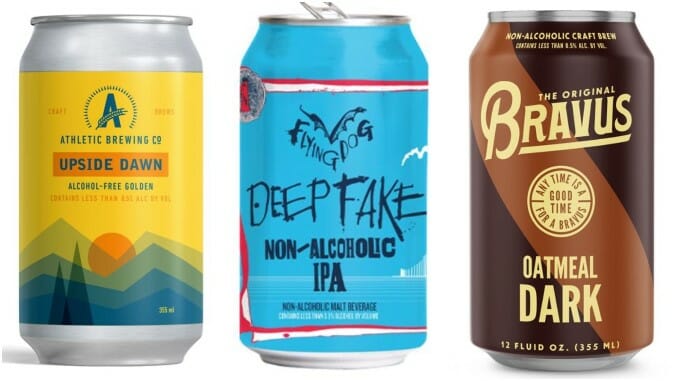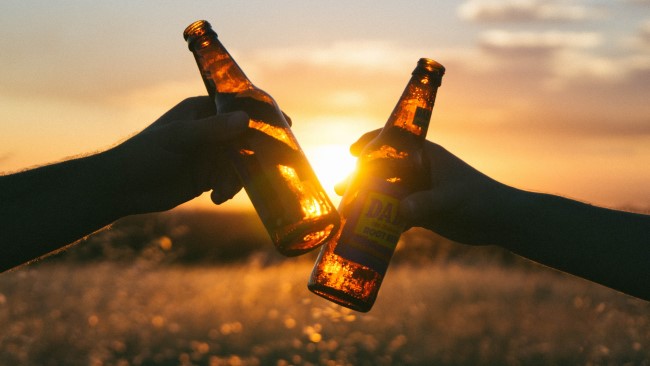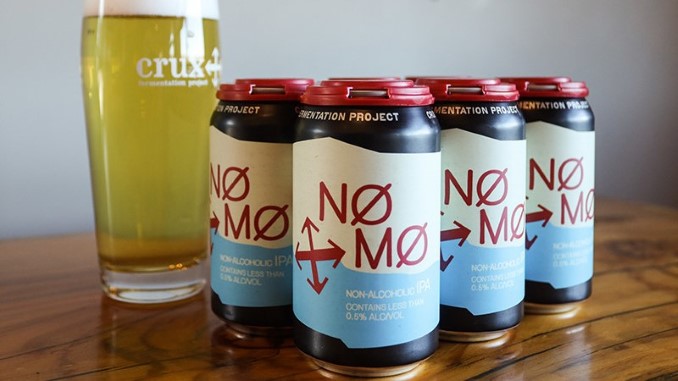Why I Love the Continuing Growth (And Improvement) of Non-Alcoholic Beer
Photos via Unsplash, Wil Stewart Drink Features craft beer
For as long as modern, non-alcoholic beer has existed, it has contended with at least some level of two-pronged stigma against it. On the most basic level, there was the enduring societal stigma—an unfair connotation with alcoholism that for decades tended to imply that anyone drinking non-alcoholic beer must be doing so because they were unable to responsibly “handle” traditional beer. This cast the image of non-alcoholic beer as the sad consolation prize of beverages, a participation trophy for a night out, handed out to those pitiable individuals who couldn’t hold their liquor, or were “taking one for the team” as a designated driver. That non-alcoholic beer would be something “less than” was treated as almost a given—it was meant to be understood that nobody would be drinking it by choice.
At the same time, there has often been a second strain of stigma, flowing not from the general public but from beer geeks themselves, who tended to characterize all non-alcoholic beer as soulless, foul-tasting corruptions of the beverage they love. Perhaps seeing it as an extension of the hated Big Beer complex, companies like AB InBev that owned foundational early NA beer brands (O’Douls, etc), craft beer drinkers have been especially dismissive of NA beer over the years. A craft beer lover, in fact, could often expect to be derided by friends for admitting they drank it, in the same way they might have been mocked for buying a case of Busch Light. To the dedicated beer explorer of the 2000s and 2010s, NA beer had to eternally fight the perception that it was incapable of being anything more than “swill.”
For a few decades, at least, that’s the uphill battle that NA beer was constantly fighting. But here in 2022, it’s safe to say that the category has finally cleared some of its most prominent obstacles, not the least of which has been a massive improvement in the average quality of the offerings on the shelf. Non-alcoholic beer has improved dramatically and broadened considerably as a style, or more accurately a constellation of genuine and familiar craft beer styles, within the space of only half a decade. It’s being consumed by more people than ever, on more occasions than ever, and produced by more craft breweries than ever. And along the way, NA beer has managed to rehabilitate its image, flipping the script on who drinks non-alcoholic beer, when they drink it, and why they choose to do so. It’s something I love to see, and it feels great to say the following without a hint of shame or irony: I’m a non-alcoholic beer fan.
 A non-alcoholic cheers feels weird at first, but you quickly get used to it.
A non-alcoholic cheers feels weird at first, but you quickly get used to it.
Of course, I’m also a fan of traditional craft beer styles, and I think it’s safe to say that I always will be. I’ve written on the subject at Paste for years, conducted endless blind tastings and watched the ebb and flow of craft beer’s boom period and subsequent regression. If you had asked me about my opinion on non-alcoholic beer as recently as say, 2018, I likely would have cracked a joke. But the last few years have been a very busy time for NA beer, and I’m by no means the only dedicated craft beer geek who has seen the value of these NA brews in that time. All around me, in fact, I see drinkers who formerly guzzled DIPA now exploring a burgeoning interest in zero-ABV hop waters, seltzers and NA beer.
For me, my interest in the NA segment really began to bloom as the product on the shelf improved and grew substantially more diverse. Years ago, saying “non-alcoholic beer” would have universally implied a very narrow range of products, all of them seemingly designed to (poorly) mimic the bland drinkability of American light lager. Today’s NA beer, on the other hand, has finally improved to the point where it can acknowledge and embrace a representative range of the myriad styles that make up the craft beer rainbow. There are still copious versions of NA light lager out there, but there are also more than passable NA amber ales, porters, stouts, pale ales, IPAs and even the occasional take on NA wild ales or sours, which represent the bleeding edge of non-alcoholic innovation. Our reviews at Paste have charted this ascent—from a dubious acknowledgement that some NA IPAs were actually pretty decent, to more recent acclaim for genuinely tasty offerings from craft breweries such as Flying Dog or Crux Fermentation Project; beers that are so close to the “real thing” that a blind taster might actually not know the difference.
 Another recent favorite in the rapidly improving sub-category of non-alcoholic IPA.
Another recent favorite in the rapidly improving sub-category of non-alcoholic IPA.
It’s the participation of these smaller craft breweries, companies seen as legitimate and respected by the craft beer geek public, that has helped NA beer along in its image rehabilitation, determinedly scrubbing away the stigma of NA beer as an inherently inferior product. A certain segment of the market was never going to be interested in something like Bud Zero or Heineken 0.0, even if they represent a quantum leap in flavor over that decades-old bottle of O’Douls. But an NA pale ale made by the local craft brewery around the corner? That’s enticing enough an idea to make even someone who has turned up their nose at NA beer for decades curious. This is how barriers are broken down, and beer drinkers begin to expand their definition of what “beer” really means to them.
And in the end, that’s what it’s all about—drinkers slowly but surely incorporating NA beer into their normal drinking habits. Far too often, the NA beer category is still presented as an alternative to regular beer, to be consumed exclusively by people who aren’t traditional beer drinkers, or teetotalers leaving the alcohol world behind entirely. Instead, a growing number of drinkers, myself included, now see NA beer as simply another aspect of the greater beer world, a product to be mixed in alongside its full-ABV brethren. Standard beer and NA beer are simply flip sides of the same coin—a drinker doesn’t have to choose between one or the other. Have a regular beer. Have a non-alcoholic beer afterward. Switch back and forth over the course of the night. It’s a moderate way to enjoy the best of both worlds, and there’s never been a better time to try some of the new NA brands on the market.
Recent drinking statistics, meanwhile, bear out the fact that not only is the category continuing to grow, with big gains in 2021 and projections that the non-alcoholic beer market will grow by roughly 31% by 2024, but that the majority of NA beer drinkers are now indeed people who do regularly consume alcohol in their daily lives. According to Nielsen, an astounding 78% of non-alcoholic beverage buyers said they also consumed standard beer, wine or spirits, suggesting that the category has increasingly found a home not with teetotalers but with those who want to incorporate NA beer into a healthy relationship with alcohol itself. Even the breweries have observed this cultural shift in progress.
 Brooklyn Brewery’s Special Effects line of NA beers now makes up more than 10% of all the company’s sales.
Brooklyn Brewery’s Special Effects line of NA beers now makes up more than 10% of all the company’s sales.
“The way people choose to consume alcoholic and non-alcoholic beverages is changing so fast, and that hard line in the sand between the drinkers and non-drinkers is quickly eroding,” said Mitch Cobb, co-founder of Upstreet Craft Brewing and Libra, a no-ABV beer, in an interview with Forbes. “We see this a lot in our taprooms and retail stores. People will come in to have a beer after work followed by two NA beers or will drink NA beer during the week and traditional craft beer on the weekend, or buy both four-packs of IPAs and NA beer for their party.”
This month across the U.S., NA beer sales will again see their annual uptick thanks to Dry January, the concept of giving up alcohol in the first month of the year to experience a lifestyle without one of American society’s most popular social lubricants. I don’t participate in earnest, in the sense of taking an entire month off from booze, but I do believe in the value of the month in the sense that it inherently continues to expand awareness of NA beer’s revitalization. An appreciation for non-alcoholic beer built in January is the kind of subtle lifestyle change that can easily be incorporated into a more moderate lifestyle year round, in a way that doesn’t have to be labored or gimmicky. There’s really no downside—not even flavor, which was for so long the Achilles heel of the segment.
The future of non-alcoholic beer is bright. That future is also flavorful, satisfying and essentially everything else the consumer likely wants from their pint, as long as they’re willing to expand their conception of what “beer” truly means.
Jim Vorel is a Paste staff writer and resident beer and liquor geek. You can follow him on Twitter for more drink writing.